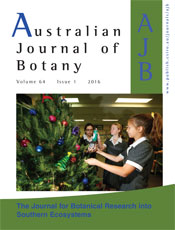Australian Journal of Botany
Volume 64
Number 1 2016
Pollination by small nocturnal mammals that are sensitive to human presence is difficult to observe directly. We used remote cameras to identity and record behaviour of vertebrate pollinators to four putatively rodent-pollinated Protea species. These cameras efficiently allowed us to observe frequent visits by at least three different rodent species to each Protea species, with occasional visits by sunbirds and genets, and we highly recommend their use in future studies involving vertebrate pollinator behaviour.
It has been hypothesized that ovule overproduction in plants could represent a ‘bet-hedging’ strategy against pollination inefficiency. We evaluated the relationship between pollination unpredictability and number of ovules per flower of the south-Andean Embothrium coccineum growing along a gradient of precipitation and pollination unpredictability. Our results showed no increase in ovule production with pollination unpredictability, but an increase in ovule production per flower with rainfall. Therefore, in this species, there was no support for the bet-hedging hypothesis. Instead, ovule number seems to be conditioned primarily by resource availability.
We tested which of five different treatments would keep a cut Pinus radiata Christmas tree healthy for longest. Our results showed that branches sprayed with hairspray retained the greatest proportion (90%) of their photosynthetic health through 27 days. This study will help Australasian families keep their Christmas trees greener and healthier over the festive season.
As part of a program to breed sterile triploid varieties of tropical Acacia, a series of inter-and intra-specific crosses were made. We report variation in seed-crop development from anthesis to harvest, in comparison with that after open pollination of the respective parent trees. This study contributes new knowledge of the post-anthesis timeline for ovule, pod and spike abscission and discusses the likely genetic and environmental causes of observed differences between inter-and intra-cytotype crosses as well as the implications for breeding.
Ability of plants to provide cooling in the urban environment is increasingly recognised. Plants use various mechanisms to regulate leaf temperature, so we investigated how several leaf traits (hairiness, colour, thickness) and processes (leaf water loss) rank in their contribution to the leaf-temperature regulation. We showed that the relative importance of water loss and leaf traits for leaf temperature varied with plant genera. This can lead to different plant types having significantly different potentials for cooling in applications such as green roofs.
We experimentally determined how an apparently unpalatable and fire-sensitive shrub, Richea acerosa , responded to the single and interactive effects of grazing and burning over 3–24 years at two subalpine sites in Tasmania. The persistence of R. acerosa appears to require an absence of frequent fire and the presence of sufficient grazing pressure from vertebrate herbivores to produce lawn between shrubs.
Population viability was assessed for four of the rarest orchids in Western Australia. Surveys conducted by volunteers increased population-size estimates by up to 10 times and provided spatial data to define core habitat areas. Vital statistics data from transects revealed annual rates of emergence, flowering, grazing and seed-set. Vital statistics report cards were produced with thresholds to inform conservation management.
Australian native Rytidosperma species (wallaby grasses) exhibit a wide range in their intrinsic growth rates and responses to phosphorus (P) fertiliser. The present paper examined whether P-utilisation efficiency (PUE) in shoots and leaf morphology influenced the large differences in growth responses to P application among Rytidosperma species. Faster-growing species had among the highest PUE, regardless of which measure was used; yet, they retained shoot-morphology traits that are usually associated with nutrient conservation and slow-growing species.
When and where did the iconic, hard-leaved, woody-fruited, Australia-wide genus, Hakea, evolve? We used area-assignment techniques to show that Hakea originated in the nutrient-poor, drought- and fire-prone heathlands of south-western Australia 18 million years ago and then spread throughout Australia as suitable habitats became available. The results help explain the renowned species richness of SW Australia and the role of environmental stress in speciation.




